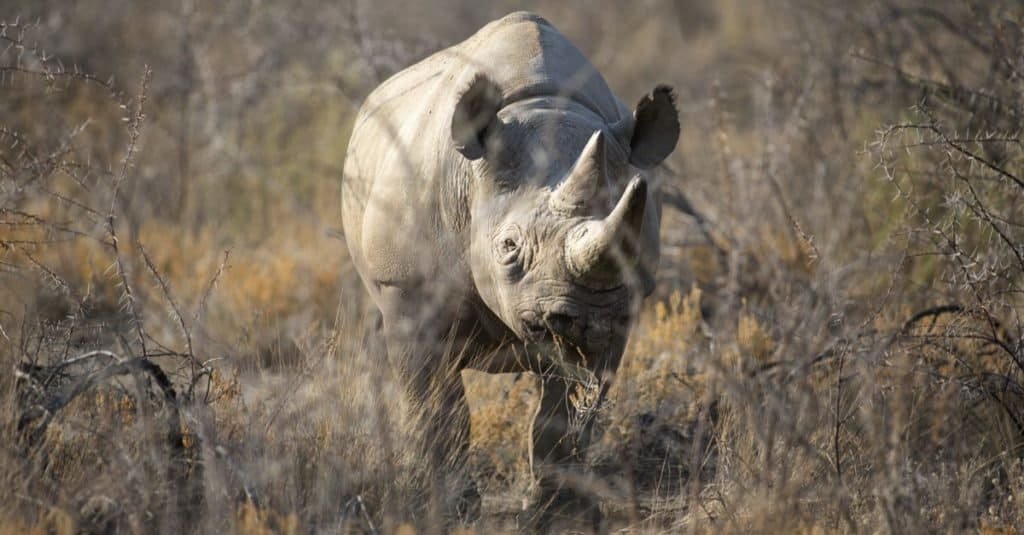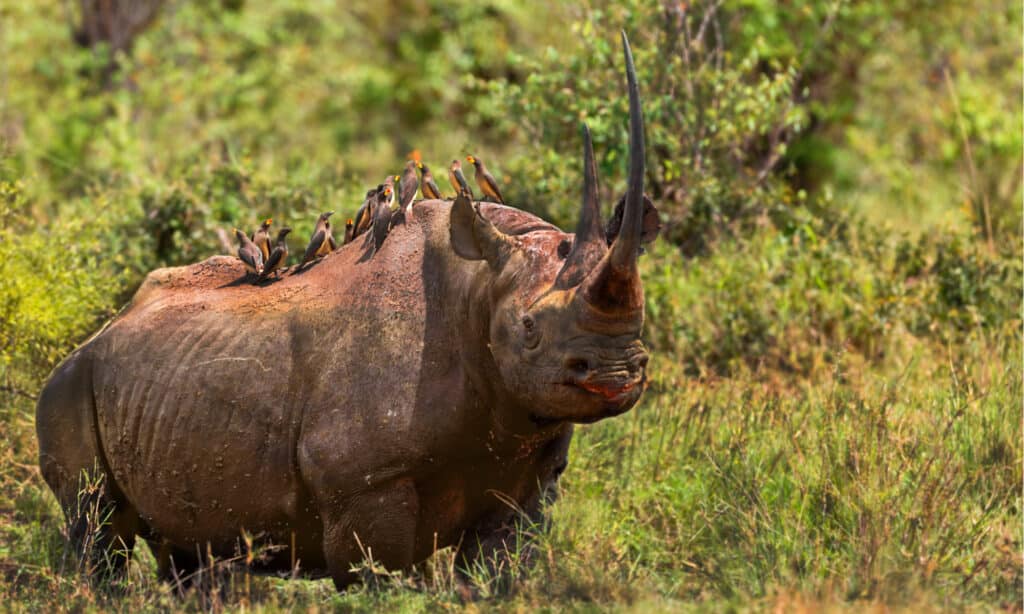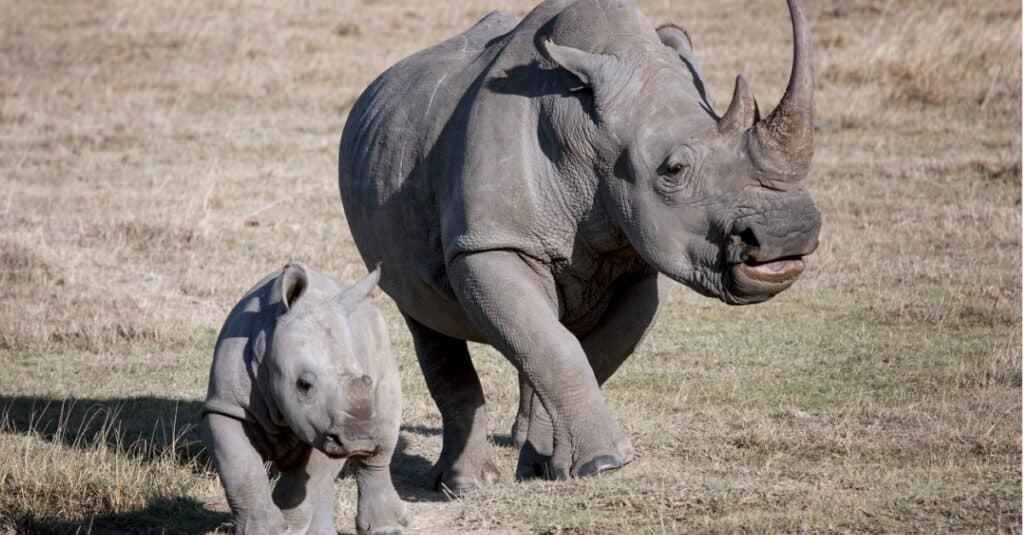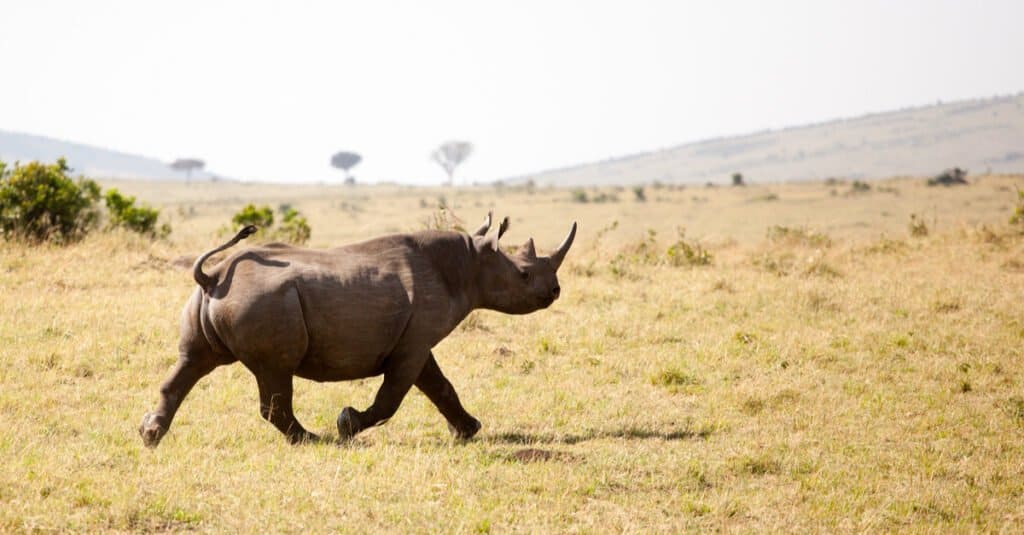The black rhino is one of the most commonly pictured rhinoceros in the media. Interestingly enough, the black rhino is actually gray in color, not black, as their name would lead you to believe. In fact, the word rhinoceros comes from the Greek language. The word rhino means nose, and ceros means horn. It is most common to find black rhinos in Tanzania, in East Africa, where they typically live between 35 and 50 years. They are incredibly majestic animals and are the third biggest of the five types of rhinos.
So how much do you know about black rhinos? Here’s what black rhinos eat, as well as other interesting facts about black rhinos.
A Quick Rundown on the Black Rhinoceros

Black rhinos can grow to be almost 3,000 pounds.
©2630ben/Shutterstock.com
In Africa, black rhinoceros inhabit grasslands and reserves alongside white rhinoceros. Among land mammals, rhinoceros are the second largest after elephants. Among the rhino species, the black rhino is the third largest. On average, black rhinos grow to 4.9 feet high and weigh almost 3000 pounds. In spite of their bulky appearance, they are actually able to move fairly quickly. In fact, black rhinoceros can run at speeds that approach 35 miles per hour.
Despite the fact that black rhinos and white rhinos are basically the same color, they differ in many other ways. Black rhinos have hooked upper lips that they use to grab leaves from trees and bushes. It would be more accurate to describe them as browsers rather than grazers. However, the size of their two horns is somewhat similar to one another. It is also known that the black rhino has the highest combat death rate among all mammals. Half of all males who fight to the death die as a result of their actions.
Having gained a greater understanding of black rhinos, let’s see what the black rhinos eat.
What Do Black Rhinos Eat?

The black rhino is a herbivorous browser that spends its time eating leafy plant material.
©Maggy Meyer/Shutterstock.com
Black rhinos eat a diet that consists of leafy plants, branches, fruit, thorny bushes, and shoots. In terms of feeding, they are herbivorous browsers, meaning they consume mostly leafy plant material, such as leaves and twigs from trees, shrubs, herbs, and forbs, but also fruits. The best habitat for them to feed in seems to be one with thick vegetation and bushland, often with some woodland. Black rhinos love eating plants, and they are known to eat up to 220 different species of plants.
According to a study published in the African Journal of Ecology, black rhinos do have a few key plants that are their preferred foods, and during the dry season, they tend to select leafy plants. During non-dry seasons, they seem to be more attracted to woody plants. There is also evidence that black rhinos prefer quality food over quantity, with more populations found in areas with better quality food sources.
Having gained a better understanding of the black rhino’s diet, let’s take a look at the complete list.
Complete List of the Black Rhinos Diet
The black rhino is a herbivorous browser, meaning that they acquire much of their diet from picking at leaves and twigs.
A black rhino’s diet consists of the following:
- Trees
- Shrubs
- Leaves
- Branches
- Twigs
- Fruits
- Tree bark
In addition to what we mentioned above, they have also been known to show a particular affection towards certain vegetation, including acacia shrubs, which they like to eat. It is now time to learn how black rhinos obtain their food in order to survive.
How Do Black Rhinos Forage for Food?
In contrast to white rhinos, black rhinos browse for their food sources. They developed their particular lip form as a result of this specific feeding behavior. They can grasp branches and hold foliage easily with their pointed, claw-like lips. As they bite into woody vegetation, they produce a neat, angular mark, similar to that which is left by pruning shears on woody plants. White rhinoceros, on the other hand, are animals that graze, walking with their large heads, muscular necks, and square-shaped lip close to the ground in order to avoid predators.
Generally, black rhinos feed between dusk and dawn, remaining within a relatively small geographical area where they can find abundant vegetation and water. Despite having poor eyesight, black rhinos are able to navigate, find palatable foliage, and identify the scent of their fellow rhinos by their keen sense of smell and hearing. Most black rhinos live on savannahs in which there are nutrient-rich soils, trees at low heights, woody plants, herbs, and succulents that are tasty to them.
What Do Baby Black Rhinos Eat?

Baby rhinos depend on their mother’s milk for survival until they can browse for food on their own.
©iStock.com/robru
There is no doubt that baby rhinos are one of the cutest animals in the African savannah. Depending on whether they survive their first few years of life, baby rhinos can grow into one of Africa’s largest and most impressive animals, with majestic horns to match their size. A baby rhino is called a calf. The average black rhino calf weighs between 77 and 110 pounds – not small at all!
For a rhino baby to grow big and strong, its mother’s milk is essential. A very unique feature of rhino milk is that it is extremely low in fat, which makes it quite unusual. There is a possibility that this could be due to the mother’s long lactation period since calves can continue to drink the milk for a year or more. So, producing milk that contains plenty of nutrients and calories would be overwhelming for the mother.
It is necessary for calves to prepare their bodies for the adult diet before they are fully weaned. This is specifically due to the lack of bacteria in their digestive systems at birth, which is essential for digesting vegetation. Where does this bacteria come from? How does it get into their body? The way they do this is by eating the excrement of their mother. The gut of baby black rhinos must be properly prepared by munching on droppings for a few months before browsing for the rest of their lives.
Do Black Rhinos Have Any Natural Predators in the Wild?
Other than humans, adult rhinos have no real predators out in the wild. However, baby and young black rhinos can be susceptible to being attacked by predators. A baby black rhinoceros is vulnerable to predators due to its small size, lack of aggression, and difficulty defending itself. This then leaves them susceptible to being attacked by lions, hyenas, and even African wild dogs.
However, adult black rhinos must remain vigilant against poachers. The biggest threat to black rhinos comes from humans. It is illegal to hunt and kill rhinos for their horns. As a matter of fact, rhino horn is primarily in demand in Asia, where it is used for both ornamental carvings and traditional medicinal treatments. According to legend, the horns have the ability to cure cancer, hangovers, and even impotence. In spite of this, none of this has been scientifically proven to be true.
Are Black Rhinos Endangered?

The black rhino is listed as critically endangered.
©Anya Newrcha/Shutterstock.com
Since 1986, the black rhino has been listed as “Endangered” on the IUCN Red List. Between 1970 and 1993, its population declined by 96%, and by 1996 it was classified as “Critically Endangered.” In the 1980s, the government imposed restrictions on the international trade of rhino horn, a measure that initially worked to slow down the market. Finally, as a result of extensive U.S. pressure and sanctions, China banned the trade and use of rhino horn in traditional Chinese medication in 1993.
South Africa has seen rhino poaching decline by 34% over the past six years. However, poaching incidents spiked 15% in 2021, turning all that around for the worst. Black rhino populations are now being protected by many conservation efforts.
The photo featured at the top of this post is © iStock.com/EcoPic
Thank you for reading! Have some feedback for us? Contact the AZ Animals editorial team.






